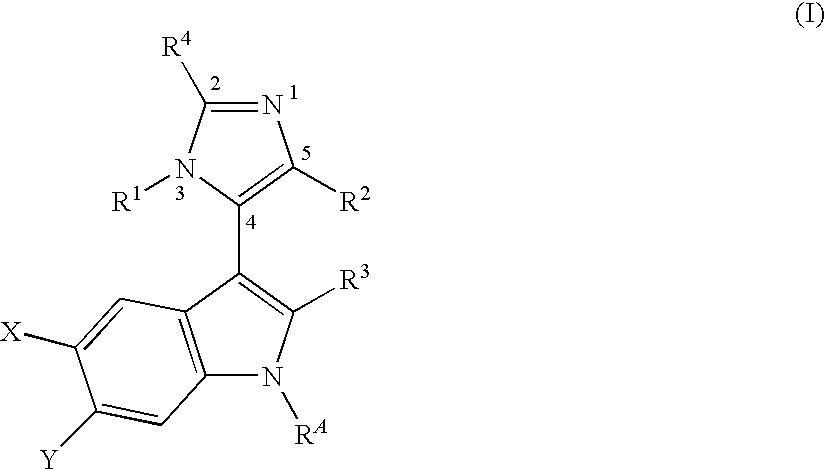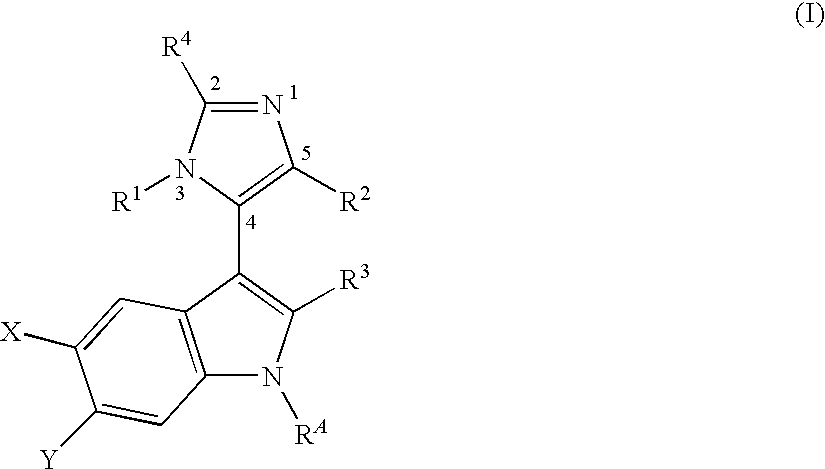3-Imidazolyl-Indoles for the Treatment of Proliferative Diseases
a technology of 3imidazolylindoles and proliferative diseases, which is applied in the direction of biocide, heterocyclic compound active ingredients, drug compositions, etc., can solve the problems of tumors, leukemias or other proliferative diseases, and uncontrolled proliferation
- Summary
- Abstract
- Description
- Claims
- Application Information
AI Technical Summary
Benefits of technology
Problems solved by technology
Method used
Image
Examples
example 1
6-Chloro-3-[3-(4-chloro-benzyl)-5-phenyl-3H-imidazol-4-yl]-1H-indole
[0274]A mixture of Intermediate 1.1 (100 mg, 0.55 mmol), 4-chlorobenzyl-amine (0.1 mL, 0.83 mmol) and 1-(isocyano-phenyl-methanesulfonyl)-4-methyl-benzene (commercially available from SynChem, Inc., Des Plaines, Ill., USA) (227 mg, 0.83 mmol) in THF (2 mL) is sealed and heated by the microwave reactor at 110° C. for 1 h. After completion, the reaction mixture is quenched by aqueous NaHCO3, EtOAc is added and the organic layer is washed with brine, dried over MgSO4 and evaporated in vacuo. Silica gel flash chromatography of the residue affords the title compound as a colorless powder; ES-MS: M+=418.0; HPLC: AtRet=4.53 min.
Intermediate 1.1: 6-Chloro-1H-indole-3-carbaldehyde
[0275]A mixture of 6-chloro-1H-indole (2.0 g, 13.2 mmol) and POCl3 (1.34 mL, 14.5 mmol) in DMF (5 mL) is heated at 45° C. for 1 h. After completion, the reaction mixture is quenched with aqueous NaHCO3, Et2O is added and the organic layer is washed ...
example 2
6-Chloro-3-[3-(4-chloro-benzyl)-5-phenyl-3H-imidazol-4-yl]-1H-indole-2-carboxylic acid (2-morpholin-4-yl-ethyl)-amide
[0276]A mixture of Intermediate 2.1 (200 mg, 0.43 mmol), N-(4-aminoethyl)-morpholine (68 mg, 0.52 mmol), NMM (109 mg, 1.08 mmol) and HATU (245 mg, 0.65 mmol) in DMF (2.2 mL) is heated for 1 h at 50° C. EtOAc is added and the organic layer is washed with brine, dried over MgSO4 and evaporated in vacuo. Silica gel flash chromatography of the residue affords the title compound as a colorless crystal; ES-MS: M+H=576.2; HPLC: AtRet=3.80 min.
Intermediate 2.1: 6-Chloro-3-[3-(4-chloro-benzyl)-5-phenyl-3H-imidazol-4-yl]-1H-indole-2-carboxylic acid (Which is Also a Compound of the Formula I)
[0277]A mixture of Intermediate 2.2 (900 mg, 1.84 mmol) and 2M aqueous NaOH (35 mL) in EtOH (35 mL) is refluxed for 2.5 h. The resulting mixture is poured into a mixture of ice and water, and after neutralized by 4 M aqueous HCl, EtOAc is added and the organic layer is washed with brine, dri...
example 137
6-Chloro-3-[3-(3,3-dimethyl-butyl)-5-phenyl-3H-imidazol-4-yl]-1H-indole-2-carboxylic acid amide
[0348]A mixture of Intermediate 137.1 (50 mg, 0.11 mmol) and 7M MeOH solution of ammonia (2 mL, 14 mmol) is heated to 60° C. After completion the reaction mixture is allowed to cool to RT, diluted with EtOAc and washed with brine, dried over MgSO4 and evaporated in vacuo. Silica gel flash chromatography of the residue affords the title compound as a colorless powder; ES-MS: M+=421.1; HPLC: AtRet=4.18 min.
Intermediate 137.1: 6-Chloro-3-[3-(3,3-dimethyl-butyl)-5-phenyl-3H-imidazol-4-yl]-1H-indole-2-carboxylic acid ethyl ester (Which is also a Compound of the Formula I According to the Invention)
[0349]The title compound is synthesized by condensation of Intermediate 2.3, 3,3-dimethylbutylamine and 1-(isocyano-phenyl-methanesulfonyl)-4-methyl-benzene analogously to the preparation of Intermediate 2.2 as a colorless solid; ES-MS: M+=450.0; HPLC: AtRet=4.77 min.
PUM
| Property | Measurement | Unit |
|---|---|---|
| volume | aaaaa | aaaaa |
| emission wavelength | aaaaa | aaaaa |
| emission wavelength | aaaaa | aaaaa |
Abstract
Description
Claims
Application Information
 Login to View More
Login to View More - R&D
- Intellectual Property
- Life Sciences
- Materials
- Tech Scout
- Unparalleled Data Quality
- Higher Quality Content
- 60% Fewer Hallucinations
Browse by: Latest US Patents, China's latest patents, Technical Efficacy Thesaurus, Application Domain, Technology Topic, Popular Technical Reports.
© 2025 PatSnap. All rights reserved.Legal|Privacy policy|Modern Slavery Act Transparency Statement|Sitemap|About US| Contact US: help@patsnap.com



